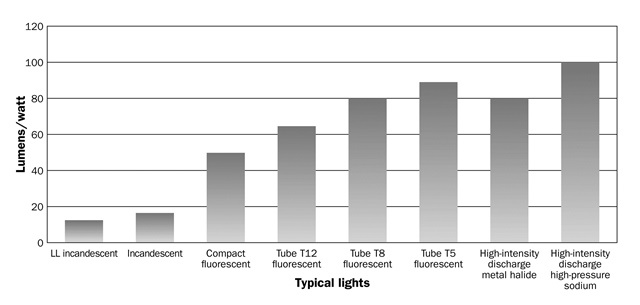Basic husbandry for commercial chicken layers
Learn basic husbandry information for raising commercial layer chickens.
ISSN 1198-712X, Published October 2013
The tables and figure in this Factsheet provide basic husbandry information for commercial layers. Proper care and management of birds and their environment result in fewer mortalities and improved egg production. Additional information on poultry production can be found at Ontario.ca/livestock.
| Incandescent bulbs (Watts) | Incandescent bulbs (Lumens) | Compact fluorescent bulbs (Watts) | Compact fluorescent bulbs (Lumens) |
|---|---|---|---|
| 25 | 270 | 5 | 250 |
| 40 | 510 | 7 | 400 |
| 52 | 780 | 9 | 600 |
| 60 | 860 | 15 | 900 |
| 90 | 1,540 | 18 | 1,250 |
| 100 | 1,680 | 26 | 1,800 |
| Fan Diameter (in.) | Range of Airflow (CFM) — all airflows measured at 0.10 in. static pressure | Average Airflow (CFM) — all airflows measured at 0.10 in. static pressure |
|---|---|---|
| 12 | 1,400–1,800 | 1,600 |
| 14 | 1,900–2,200 | 2,050 |
| 16 | 2,500–3,000 | 2,750 |
| 18 | 3,000–4,000 | 3,500 |
| 20–22 | 3,000–5,000 | 4,000 |
| 24–26 | 5,000–7,000 | 6,000 |
| 36 | 8,000–12,000 | 10,000 |
| 48 | 18,000–22,000 | 20,000 |
| 50 | 19,000–27,000 | 23,500 |
CFM=cubic feet per minute
Source: Agricultural fan performance test results from Bio-Environment Structural Systems (BESS) labs at the University of Illinois.
Accessible description for Figure 1
| Criteria | Brooding (0–6 weeks) | Pulling Rearing (6–18 weeks) | Laying (18+ weeks) |
|---|---|---|---|
Air Temperature (at bird height |
|
|
|
| Relative Humidity |
|
|
|
| Ventilation |
|
|
|
| Ammonia | Maximum of 25 ppm (parts per million):
| Maximum of 25 ppm (parts per million):
| Maximum of 25 ppm (parts per million):
|
Lighting Guidelines may vary with the strain of layer selected. | Intensity:
Duration of photoperiod:
| Intensity:
Duration of photoperiod:
| Intensity:
Duration of photoperiod:
|
| Water |
|
|
|
| Feeders |
|
|
|
| Density |
|
|
|
CFM = cubic feet per minute
ppm = parts per million
Values in this fact sheet are in imperial measurements, reflecting common usage in the ventilation industry.
This fact sheet was written by Al Dam, poultry specialist, OMAFRA, Guelph, and Kathleen Taylor, poultry research technician, OMAFRA, Guelph.
Accessible image description
Figure 1. Lumens/watt of typical light sources on farms
Bar graph showing wattage for typical lights. Y-axis (vertical) starts at 0 and goes up to 120. X-axis (horizontal) lists long-life incandescent bulbs on the left, then incandescent, compact fluorescent, tube t12 fluorescent, tube t8 fluorescent, tube t5 fluorescent, high-intensity discharge metal halide, and high-intensity discharge high-pressure sodium on the right.
